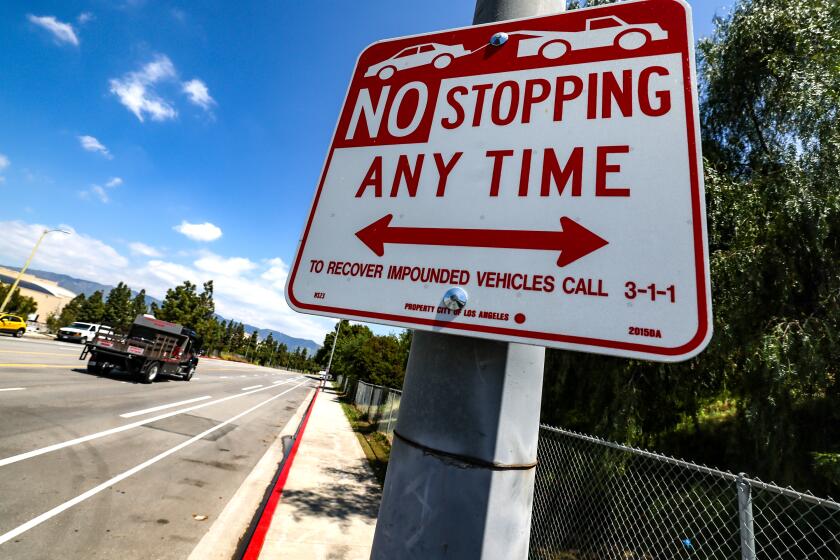Deal Would Revive San Joaquin River
A historic settlement outlining the most ambitious river restoration project in California’s thirsty history was filed in federal court Wednesday, the first major step in an effort to return year-round flows and a long-destroyed salmon run to the Central Valley’s once grand San Joaquin River.
The agreement ends an 18-year legal battle over the river, parts of which were reduced to a sandy skeleton half a century ago after most of its Sierra-fed waters were diverted to 1 million acres of San Joaquin Valley agriculture.
“The magnitude of this restoration effort -- returning water and salmon back to 60 miles of dead river -- is virtually unprecedented in the American West,” said Hal Candee, a Natural Resources Defense Council senior attorney who helped file the 1988 lawsuit that produced the settlement after years of negotiations.
The agreement among the federal government, growers and environmental groups will reduce diversions from the river by an average of 15%, releasing enough water from Friant Dam near Fresno to revive a spring chinook salmon run that was completely wiped out after the dam was built in the 1940s.
Fish passageways and screens will be constructed, the river channel will be improved in some areas and levees will be strengthened to contain the increased flows.
The project will take years and, according to estimates, will cost between $250 million and $800 million, depending on how extensive the levee work is. Funding will come from growers, the state and the federal government, which operates Friant Dam.
State Department of Water Resources Director Lester Snow called the project “an incredible opportunity” and, in a statement, Assistant U.S. Interior Secretary Mark Limbaugh termed it “monumental.”
Federal legislation has been drafted to authorize up to $250 million in federal spending for the restoration effort.
Proposition 84 on the November ballot includes $100 million of state money for the San Joaquin. Additional funds could come from other infrastructure bonds that will go before California voters this fall.
The settlement lays out various ways to help farmers make up for the water they will lose to the river. In wet years with high San Joaquin flows, for instance, growers will be able to buy discounted water from the federal government to store for future use. They probably also will buy water from other irrigation districts that don’t draw from the San Joaquin.
“We’re very encouraged that the terms of the settlement are a balanced approach for river restoration and water supply,” said Ronald D. Jacobsma, consulting general manager of the Friant Water Users Authority, representing the growers. “We’re optimistic that we can successfully implement the agreement.”
The second longest river in California, the San Joaquin runs 350 miles. It starts in the High Sierra near Yosemite National Park, flows past Fresno and then turns north across the Central Valley before emptying into the Sacramento-San Joaquin Delta near San Francisco.
In the 1800s, the river was deep and wide enough to carry steam paddleboats laden with freight and passengers. Its historic chinook salmon runs were among the biggest on the West Coast, so plentiful that farmers fed the fish to hogs.
Up to the 1940s, when Friant Dam was completed as part of the U.S. Bureau of Reclamation’s massive Central Valley Project, tens of thousands of spring-run chinook migrated to the San Joaquin’s upper reaches to spawn.
But as two huge irrigation canals running from the base of the dam swallowed up more and more of the San Joaquin’s water, miles of the river turned to dust. By the early 1950s, the spring run had been wiped out despite last-ditch rescue attempts by the state Department of Fish and Game.
State biologists trapped salmon, carted them around dry stretches in tank trucks and then dumped them back into the river near spawning grounds.
Fish and game officials even tried to use the courts to force the federal government to release enough water from Friant to keep the salmon alive. But Pat Brown, as attorney general and later as governor, quashed those attempts. The spring run disappeared.
As part of their work on the court case, National Resources Defense Council staff met with George Warner, a fish and game worker who had taken part in the trap and rescue efforts, shortly before he died last year.
“He literally went to his grave lamenting the fact that they had failed to save this amazing salmon run,” the council’s senior attorney, Jared W. Huffman, said. “I think George Warner and every one else who has fought so hard to save the San Joaquin can be very proud today.”
Not everyone was celebrating, however.
Though officials were praising the agreement at news conferences in Sacramento and at Friant Dam, representatives from irrigation districts not involved in the lawsuit were in Washington, expressing their concerns in Congress and at the Interior Department.
Those districts take water from tributaries of the San Joaquin and parts of the river not covered in the settlement. They worry that the return of the spring run, which is listed as threatened under the Endangered Species Act, could trigger protections that would affect their hydropower production and force them to give up water, as well as install costly fish screens or passages.
Ken Robbins, general counsel for the Modesto and Merced irrigation districts, said the districts hope that the federal government will declare the San Joaquin’s chinook run experimental, which would prevent protections from being imposed.
“This is not just a culture shock. It’s an energy shock and a fiscal shock -- a potential disaster,” he said.
Snow, the state’s water resources director, said he thought that the irrigation districts’ concerns could “be addressed and managed.”
The settlement must be approved by U.S. District Judge Lawrence K. Karlton, who has presided over the case in Sacramento since it was filed. Attorneys expect that to happen within the next month.
More to Read
Start your day right
Sign up for Essential California for news, features and recommendations from the L.A. Times and beyond in your inbox six days a week.
You may occasionally receive promotional content from the Los Angeles Times.







